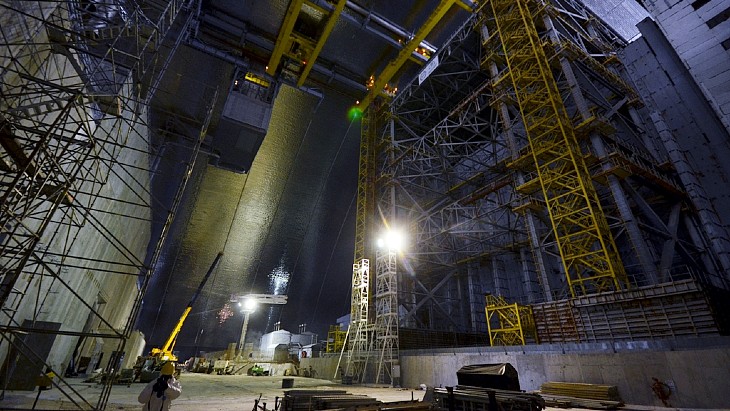Friday, 20 December 2024

He was speaking during a meeting of backers of the International Cooperation Account for Chernobyl, which was established in November 2020 by the European Bank for Reconstruction and Development (EBRD) at the Ukrainian government’s request to support a comprehensive plan for Chernobyl. The EBRD had already led the project to fund and construct the New Safe Confinement building which is now in place covering the whole of the reactor involved in the accident, including the initial shelter built around it in a matter of months.
Korikov said that equipping the New Safe Confinement with the necessary equipment and the dismantling of the unstable structures of the original shelter had already been postponed because of funding issues. This work was an integral part of the three-stage international Shelter Implementation Plan, which was firstly to stabilise it – the 2008 work gave it a design life to 2023 – and secondly to build a larger secure construction to enclose it – the New Safe Confinement (NSC) which was completed in 2017 – which would then pave the way for the dismantling and decommissioning stage.
“Further delays in the implementation of the project to dismantle the unstable structures of the Shelter under the NSC shell increase the risk of their collapse, which could lead to extremely negative consequences. This state of affairs causes serious concern for the State Nuclear Regulatory Inspectorate of Ukraine,” he said.
The Shelter Object – also known as the ‘sarcophagus’ – still contains the molten core of the reactor and an estimated 200 tonnes of highly radioactive material. The stability of the structure has developed into one of the major risk factors at the site.
The licence for the storage of radioactive waste within the shelter was extended last year from 2023 to 2029, with a 2025 deadline for the development of a new design for the dismantling of “unstable structures with an unacceptably high probability of collapse”, and a 31 October 2029 deadline for completion of the dismantling.
In October it was announced that a new study was being funded by the International Chernobyl Cooperation Account which aims to determine the scope of deconstruction work for unstable Shelter structures and provide an initial cost estimate and enable the beginning of design work for the dismantling of the unstable Shelter structures. The consultants are also tasked with “revising the criteria and requirements for the NSC infrastructure to support the dismantling of unstable structures in the Shelter. This also involves developing all necessary technical specifications, including for lifting equipment, systems for processing contaminated dismantled structures, their further transportation, engineering and control systems for” the second stage of the project and “additional radiation monitoring equipment, radiation-protected personnel transfer boxes, and other related documentation”.
In June this year members of Ukraine’s parliament approved a law approving the framework agreement between Ukraine and the EBRD which allows for the creation of a mechanism for managing the activities of the International Chernobyl Cooperation Account.
The State Agency of Ukraine for [the Chernobyl] Exclusion Zone Management also took part in the meeting and said the meeting had seen contributing countries announcing EUR7 million (USD7.3 million) of support for development of the Chernobyl exclusion zone.
It also quoted the head of the Ukrainian delegation, Minister of Environmental Protection and Natural Resources, Svitlana Hrynchuk, as saying that the meeting “approved important decisions, namely the creation of a Project Management Group for more effective implementation of grant agreements, and agreed on the direction of work on dismantling unstable structures of the Shelter Facility. Today, we have a wide range of opportunities for partnership and achievements in the direction of nuclear and radiation safety”.
She said there had been previous contributions amounting to EUR26 million with funds being “directed to the restoration of equipment destroyed and damaged during the Russian occupation, system projects of nuclear and radiation safety at the Chernobyl NPP … I am grateful to all partner countries for their unwavering position towards Ukraine and your investments in our common future”.
According to World Nuclear Association, the hermetically-sealed New Safe Confinement allows “engineers to remotely dismantle the 1986 structure that has shielded the remains of the reactor from the weather since the weeks after the accident. It will enable the eventual removal of the fuel-containing materials in the bottom of the reactor building and accommodate their characterisation, compaction, and packing for disposal. This task represents the most important step in eliminating nuclear hazard at the site – and the real start of dismantling”.
The New Safe Confinement is the largest moveable land-based structure built – with a span of 257 metres, a length of 162 metres, a height of 108 metres and a total weight of 36,000 tonnes equipped – and with a lifetime of 100 years, it has been designed to allow for the eventual dismantling of the ageing makeshift shelter from 1986 and the management of radioactive waste. It has also been designed to withstand temperatures ranging from -43°C to +45°C, a class-three tornado, and an earthquake with a magnitude of 6 on the Richter scale.













